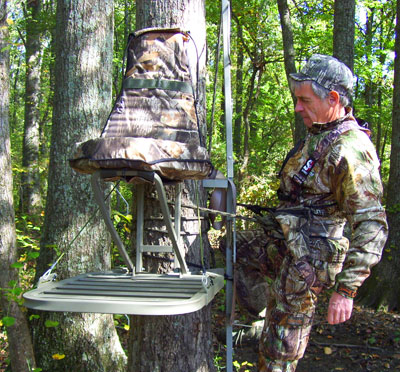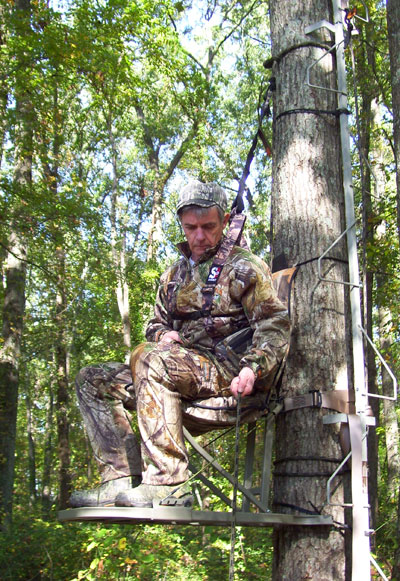 |
By Pat Lefemine
Founder Bowsite.com |
| |
You just climbed to the top run of your tree steps to start
your deer hunt. Like many people, you attach your safety rope and clip onto it
before you make the transition from the steps to the stand. As your weight
shifts from your left foot on the steps to your right foot on the stand, the
stand platform pivots, you lose balance, and you fall backward off the stand.
Luckily, you had already clipped onto your safety rope and
your fall is successfully stopped by a TMA approved safety harness system. You
are now dangling 18’ in the air. You have a couple of bruises, but you’re not
seriously injured. All is good – right? Well, not exactly.
Now what?
Here at Bowsite.com ( and in other bowhunting publications)
we all spend a lot of time talking about preventing falls by using full-body
safety harnesses. We’ve even tested harness systems for you by intentionally
jumping out of tree stands. But in all of these articles there is always
something missing: What do you do after you’ve fallen? This article and accompanying video is
specifically addresses this question by focusing on these areas:
- Ways
to position your stand, steps, and safety system in the event of a fall.
- Equipment
to have on hand in case you do fall
- Techniques
employed to transition you from a suspended state, back to the stand or ground
First, know this:
You can die from a treestand fall even after your full-body
safety harness has stopped it and you never hit the ground!
It is called suspension
trauma and it can kill you if your blood is not properly circulating
through your legs. The first signs of suspension trauma is dizziness and
fatigue. Eventually the person suspended will black out and die if they remain
in a suspended state for long periods of time. For this reason it is critical
that you have an exit strategy after you’ve fallen. Unfortunately, most people
never give consideration to what to do after they’re suspended.

Summit's Keith Jones is the inventor of the SOP Safety Harness
While researching this feature we
reached out to Keith Jones of Summit Treestands. Keith probably knows more
about treestand safety equipment and techniques than anyone else in our
industry. He was the original developer of the Seat-O-The-Pants (SOP) safety
harness. Keith has spent a considerable amount of time designing harnesses
that not only protect you from a fall, but which are also designed to prevent
suspension trauma. He has also tested and perfected techniques that he shared
with us when we were producing this article.
|
Discuss This Feature on the Bowsite Forums
Stand, steps and rope positioning
1. Tether
and tree rope as high as possible - The most important consideration with
your setup is the position of your tether and tree rope. The tree rope and
tether should be high enough so you can feel a gentle tug on you when you lean
forward while sitting in your treestand. The higher up you can get this
tether, the quicker it will catch you, and suspend you within reach of the
treestand. You do not want to fall 3’ below your stand as you’ll have no way of
reaching it. Many guys put the rope at chest level, but this is incorrect. It
should be above your head. Remember, the rope and tether will stretch and the harness
will naturally shift up when you fall. Besides the safety aspect, a high
tether provides a natural pivot point above your shoulders which allows you to
move freely in your stand.

Place your tether connected tree rope as high as possible
2. Tether
positioned where you want to fall - Assuming you have positioned the tether as
high as possible, where the tether connects to the tree rope will determine
where you will hang. For example, a tether connected 6” to the right edge of
your treestand will swing you out (in a fall) and land you to the right of the
treestand. (hang on with steps) If you’re like me you probably run your
steps up the left side of the stand so you can step down and onto the stand
with your right foot. So wouldn't’t you naturally position the tether to the
left of your stand so you are hanging right next to your treesteps? Maybe, but
I prefer not to do this since you can be seriously injured or impaled by the metal
treesteps. Instead, position your tether connection as close as possible to
your stand. It should be within easy reach so you can try to climb back onto it.
(Climbing Stand) Climbers are easier. Assuming you have positioned your
tether so you can reach your climbing treestand, you can simply lift up the
platform section and lower the stand until you can safely step onto it. As
always, be sure your hand portion and platform are connected by a cord or rope.
And whatever you do don’t let it slide down the tree, if that happens you are
in serious trouble.
Equipment to have on hand in case you fall
Carry the following items in a pouch or pocket of your
safety harness. If you wear your harness under your coat, keep these items in
your coat pocket.
- Cell
Phone – always have a cell phone and call someone after you fall.
- Whistle – remember the movie titanic? Same principle applies here.
- Folding
Tree step - in the event you are unable to climb back onto your stand use one
of these.
- Folding
Pocket Knife – there are many uses for this, just make sure it’s folded.

Techniques for transitioning yourself back to safety
From a Fixed position treestand
with a reachable platform
- Don’t
panic, use a moment to formulate a plan
- Pull
out your Tension Relief Strap and tie the lose end to the lineman D-ring. Stand
up to relief tension immediately, occasionally switching legs.
- Pull
out your cell-phone and call someone who knows where you are. Tell them your exact
location, the time you fell, and your status (injured, bleeding, etc). Tell
them your plan and ask them to call back within 5 minutes. Instruct them if
they do not hear from you to send help immediately.
- Flip
around to face your treestand and pull one leg out from your Suspension Relief and
place your knee on the stand platform and stand up.
- Place
a call to the contact you phoned while hanging and give them your status and
any additional instructions.
From a Fixed position treestand
with reachable strap-on climbing steps
- Don’t
panic, use a moment to formulate a plan
- Pull
out your Tension Relief Strap and tie the lose end to the lineman D-ring. Stand
up to relief tension immediately, occasionally switching legs.
- Pull
out your cell-phone and call someone who knows where you are. Tell them your exact
location, the time you fell, and your status (injured, bleeding, etc). Tell
them your plan and ask them to call back within 5 minutes. Instruct them if
they do not hear from you to send help immediately.
- Reach
the lowest strap-on tree step you can and swing it around so you can stand up
on it. Do this with each step until you can reach your treestand.
- Climb into your
treestand and place a call to the contact you phoned while hanging and give
them your status and any additional instructions.
From a Fixed position treestand
with unreachable steps or branches
- Don’t
panic, use a moment to formulate a plan
- Pull
out your Tension Relief Strap and tie the lose end to the lineman D-ring. Stand
up to relief tension immediately, occasionally switching legs.
- Pull
out your cell-phone and call someone who knows where you are. Tell them your exact
location, the time you fell, and your status (injured, bleeding, etc). Tell
them your plan and ask them to call back within 5 minutes. Instruct them if
they do not hear from you to send help immediately.
- Reach
into your vest and pull out a screw-in tree step. Use this to climb back onto
your treestand.
- Place
a call to the contact you phoned while hanging and give them your status and
any additional instructions.
From a Climbing treestand
- Don’t
panic, use a moment to formulate a plan
- Pull
out your Tension Relief Strap and tie the lose end to the lineman D-ring. Stand
up to relief tension immediately, occasionally switching legs.
- Pull
out your cell-phone and call someone who knows where you are. Tell them your exact
location, the time you fell, and your status (injured, bleeding, etc). Tell
them your plan and ask them to call back within 5 minutes. Instruct them if
they do not hear from you to send help immediately.
- Flip
around to face the tree and gently lift up the platform section of your climber
and continue lowering it until you can easily place your foot on the platform.
- Climb
into your treestand and place a call to the contact you phoned while hanging
and give them your status and any additional instructions.

Always wear your harness - we'd like you to visit us again!
|